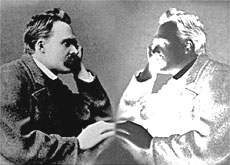A sea of tranquillity and philosophy

Friedrich Nietzsche was one of a wealth of intellectuals, musicians and artists who found inspiration in the Swiss Alps. But it was barren ruggedness – rather than prettiness – that spawned some of his greatest works.
Sils Maria lies sprawled atop the Maloja Pass in Graubünden’s Engadine region.
Here, a large stretch of lake, a sprinkling of villages and the sheer rock face of bare mountains towering over the expanse make for a very unique landscape.
In a letter Nietzsche once referred to it as being “heroic and idyllic”. This is where the philosopher penned part of his widely acclaimed work, Thus Spoke Zarathustra.
More than a century after the summers he spent there in the 1880s, the area has undergone relatively few changes. The philosopher rented a room in the two-floor whitewashed building, which at the time housed a little shop.
Great walker
“Fortunately, you can’t change mountains or lakes,” says Joachim Kung, a Nietzsche scholar and the curator of the Nietzsche House in Sils Maria.
“Of course the area today is very touristy, but you can still find places where you can go for walks alone. Sils has also tried to keep away mass-tourism, so for instance, the parking lots have been put underground.”
Nietzsche suffered from migraine headaches, nausea, poor eyesight and, later in his life, severe mental problems. But he was a great walker, and he firmly believed in the power of external conditions on the inner being.
“Remain seated as little as possible,” he wrote in Ecce Homo. “Put no trust in any thought that is not born in the open to the accompaniment of free bodily movement.
“Nor in one in which even the muscles do not celebrate a feast. All prejudices take their origins in the intestines, a sedentary life, as I have already said elsewhere, is the real sin against the Holy Spirit.”
To Nietzsche, the Maloja area represented the ideal bridge between water and mountains. The Chasté peninsula, which juts into Lake Sils just a short walk from his house, was one of his favourite spots.
Persecuted
Today, as at the end of the 19th century, the visitor can walk out to it and sit on the rocky shoreline, contemplating the peacefulness of the water and the dominating peaks that rise above it.
The people of Sils Maria who viewed Nietzsche with affectionate bemusement, told stories of Nietzsche being persecuted by mischievous schoolchildren when he came here on his many walks.
“The youngsters would see him walking by the lake and would put handfuls of pebbles into his umbrella,” recounts Kung with a chuckle, “So when he later unknowingly opened it, he would be showered by tiny stones from the lakeshore!”
What Nietzsche appreciated about the area was its uncultivated nature. To him it was a type of nature which man could feel a part of, but which he was unable to control.
He was also drawn by the dry, sunny climate, which was beneficial to his health – although the bitterly cold temperatures Sils Maria experiences even in summer caused him much suffering.
“It was seven degrees Celsius in his bedroom in the summer months,” Kung explains, “and Nietzsche wrote to his mother begging her to send him socks and gloves.”
It is in that very bedroom that one finds perhaps the most curious of Nietzsche’s links to another great mind: the wooden desk at which the philosopher wrote his works looks out onto a modest chalet, partly hidden by trees.
What Nietzsche could not have known at the time, was that the young Jewish Dutch girl, Anne Frank, would spend two summers in that very chalet several decades later. It was her great-aunt’s house.
“The funny thing is that one of the elderly ladies of the village recently decided to visit the Nietzsche Haus for the first time,” says Kung.
“They hardly ever come to the museum, but this lady did, and she came across a poster – one of many we have here for exhibitions or talks being held – depicting Anne Frank. She immediately exclaimed that the girl had been one of her childhood playmates…but she had no idea of who Anne Frank was!”
The Nietzsche Haus displays manuscripts, letters, works and even the man’s death mask.
But it mainly serves as a meeting place for Nietzschean scholars, offering them board and lodging, and organising discussions, debates and exhibitions immersed in the scenery that so inspired the great philosopher.
Nietzsche was born in 1844 in the German town of Röcken.
In 1869, appointed professor of classical philology at the University of Basel.
His writing included:
Beyond Good and Evil
On the Genealogy of Morals
Thus Spoke Zarathustra
The Will to Power
(This story was first published in 2000.)

In compliance with the JTI standards
More: SWI swissinfo.ch certified by the Journalism Trust Initiative
You can find an overview of ongoing debates with our journalists here. Please join us!
If you want to start a conversation about a topic raised in this article or want to report factual errors, email us at english@swissinfo.ch.